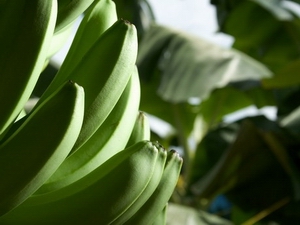Banana cul tivation, which provides employment to around 170,000 people in Colombia, can supply the raw goods necessary to manufacture industrial fibres that are more resistant to degradation.
tivation, which provides employment to around 170,000 people in Colombia, can supply the raw goods necessary to manufacture industrial fibres that are more resistant to degradation.
The manufacture of automobiles, panels for housing, sports articles, household goods and countless other utensils requires sophisticated materials able to withstand heavy use and wear. Polymers, which are large-sized molecules of natural or artificial origin, are used to strengthen the structure of such utensils.
The most commonly used are plastics (polyethylene, polychloride, polypropylene, etc.) and glass and carbon fibres; however, scientists seek new compounds that offer the advantages of both resistance and low cost. Banana fibres have therefore become a very promising option.
"According to data provided by the Ministry of Agriculture and Rural Development, in the year 2011, 353,297 hectares were cultivated, with a production of 2,815,693 tonnes. The leftovers (leaves and stalks), instead of being disposed of, could also bring in revenue for the industry," explains the agronomist Yamileth Cuartas Betancurth, lecturer at the University of Caldas.
Its reproductive cycle lasts from 10 to 12 months. After the harvest, profits are only made from the fruit. The rest is used as fertiliser or is disposed of. A project from the Department of Industrial Engineering of the National University of Colombia, in Manizales, managed to use the plant's stalk to obtain a high quality reinforcing material.
This breakthrough will bring a new revenue source for growers, who will be able to extract the fibres with machines and sell them to the industry.
A more uniform surface
Glass and carbon are the inorganic materials most used by the industry, especially for their durability. In contrast, natural fibres are irregular due to their cellulose, hemi-cellulose and lignin composition, which makes them unsuitable for reinforcing materials.
To change this situation, Lady Johana Rodríguez, Master in Industrial Engineering, developed a chemical process which modifies the internal structure of banana fibres. This innovation makes it possible to obtain more uniform surfaces, with a better resistance to environmental corrosion, high temperatures and water absorption (they are hydrophobic).
The treatment consists in their submersion, for 24 hours, in a compound made of epichlorohydrin, an anhydrous acetic reactant and acetone. They are washed in acetone and distilled water and dried in an oven for a day. They are afterwards tested for resistance, hydrophility (water absorption), heat and alkalinity.
"Once treated, the fibres repelled water by up to 33.3% and their resistance to air moisture increased by 32.43%, extending their durability. Additionally, be means of micrographs made with scanning electron microscopes, it was observed that the surface was smoother, leading to a perfect adhesion to the polymer matrix," stated the researcher.
 tivation, which provides employment to around 170,000 people in Colombia, can supply the raw goods necessary to manufacture industrial fibres that are more resistant to degradation.
tivation, which provides employment to around 170,000 people in Colombia, can supply the raw goods necessary to manufacture industrial fibres that are more resistant to degradation.The manufacture of automobiles, panels for housing, sports articles, household goods and countless other utensils requires sophisticated materials able to withstand heavy use and wear. Polymers, which are large-sized molecules of natural or artificial origin, are used to strengthen the structure of such utensils.
The most commonly used are plastics (polyethylene, polychloride, polypropylene, etc.) and glass and carbon fibres; however, scientists seek new compounds that offer the advantages of both resistance and low cost. Banana fibres have therefore become a very promising option.
"According to data provided by the Ministry of Agriculture and Rural Development, in the year 2011, 353,297 hectares were cultivated, with a production of 2,815,693 tonnes. The leftovers (leaves and stalks), instead of being disposed of, could also bring in revenue for the industry," explains the agronomist Yamileth Cuartas Betancurth, lecturer at the University of Caldas.
Its reproductive cycle lasts from 10 to 12 months. After the harvest, profits are only made from the fruit. The rest is used as fertiliser or is disposed of. A project from the Department of Industrial Engineering of the National University of Colombia, in Manizales, managed to use the plant's stalk to obtain a high quality reinforcing material.
This breakthrough will bring a new revenue source for growers, who will be able to extract the fibres with machines and sell them to the industry.
A more uniform surface
Glass and carbon are the inorganic materials most used by the industry, especially for their durability. In contrast, natural fibres are irregular due to their cellulose, hemi-cellulose and lignin composition, which makes them unsuitable for reinforcing materials.
To change this situation, Lady Johana Rodríguez, Master in Industrial Engineering, developed a chemical process which modifies the internal structure of banana fibres. This innovation makes it possible to obtain more uniform surfaces, with a better resistance to environmental corrosion, high temperatures and water absorption (they are hydrophobic).
The treatment consists in their submersion, for 24 hours, in a compound made of epichlorohydrin, an anhydrous acetic reactant and acetone. They are washed in acetone and distilled water and dried in an oven for a day. They are afterwards tested for resistance, hydrophility (water absorption), heat and alkalinity.
"Once treated, the fibres repelled water by up to 33.3% and their resistance to air moisture increased by 32.43%, extending their durability. Additionally, be means of micrographs made with scanning electron microscopes, it was observed that the surface was smoother, leading to a perfect adhesion to the polymer matrix," stated the researcher.





